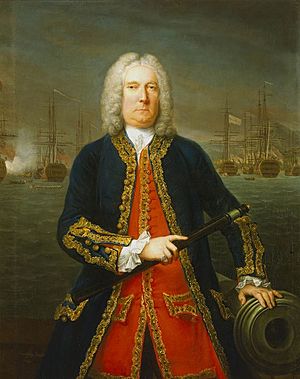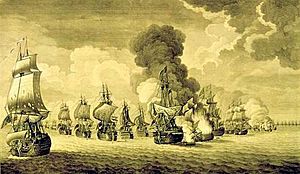Thomas Mathews facts for kids
Quick facts for kids
Thomas Mathews
|
|
|---|---|

Admiral Thomas Mathews, 1743, by Claude Arnulphy.
|
|
| Born | October 1676 Llandaff Court, Llandaff |
| Died | 2 October 1751 (aged 74–75) Bloomsbury Square, London |
| Allegiance | |
| Service/ |
|
| Years of service | 1690–1747 |
| Rank | Admiral |
| Commands held | HMS Yarmouth HMS Kingsale HMS Gloucester HMS Chester HMS Prince Frederick HMS Kent |
| Battles/wars | |
Thomas Mathews (born October 1676, died 2 October 1751) was a British officer in the Royal Navy. He rose through the ranks to become an admiral, a very important leader in the navy.
Mathews joined the navy in 1690. He served on many ships during important conflicts like the Nine Years' War and the War of the Spanish Succession. He sometimes took breaks from commanding ships to spend time at his family home in Llandaff. He showed great skill at the Battle of Cape Passaro in 1718. After this, he led groups of ships in the Mediterranean Sea and the Indian Ocean. He then mostly retired from active navy duty.
In 1741, Mathews returned to service when Britain joined the War of the Austrian Succession. He took charge of the British fleet in the Mediterranean. This job was tricky because he also had to handle diplomatic tasks. To make things harder, he did not get along with his second-in-command, Richard Lestock. The most important moment of his career came in 1744. He tried to stop a combined French and Spanish fleet at the Battle of Toulon. The battle was confusing, with poor communication and problems in the chain of command. Even though Mathews had more ships, he could not win a clear victory. The enemy fleet escaped, losing one ship. Mathews' fleet also lost one ship and had several others badly damaged.
The British public was very upset that the navy did not win. Many investigations and court cases followed. Several officers were dismissed from the navy. Lestock, Mathews' second-in-command, was tried but found innocent. He blamed Mathews for the battle's outcome. Mathews was also tried and found guilty. He was dismissed from the navy. He went back to his home in Llandaff. Later, he moved to London, where he died in 1751.
Contents
Thomas Mathews was born at Llandaff Court in Llandaff. His father was Colonel Edward Mathews, who died in 1700. His mother's grandfather was Sir Thomas Armstrong. Mathews joined the navy in 1690. He served on HMS Albemarle, a ship commanded by his uncle, Sir Francis Wheler.
Mathews served during the Nine Years' War. He might have been at the Battle of Beachy Head. He was likely involved in the Battle of Barfleur. In 1697, Mathews served on HMS Portland. In 1699, he became a lieutenant on HMS Boyne. He served in the Mediterranean Sea and then on HMS Deale Castle in 1700. Mathews later served in the West Indies. He was promoted to command HMS Yarmouth in 1703.
Leading Ships and Squadrons
From 1704, Mathews commanded HMS Kingsale in the English Channel. In 1708, he took command of HMS Gloucester. His next ship was the new HMS Chester. This ship was part of the Channel fleet. In 1709, the British fleet met a small French squadron. The British chased them. They recaptured one of the French prizes and captured another French ship.
Mathews and Chester then joined a fleet sent to capture Nova Scotia in 1710. Mathews took over command of this force later. In 1711, he joined another fleet in Boston. He then escorted a group of ships to New York City. Chester was badly damaged by storms during this trip. It returned to Britain for repairs. Mathews then spent several years at his family home in Llandaff.
Mathews returned to active service in 1718. This was due to the start of war with Spain. He temporarily commanded HMS Prince Frederick. He then took command of HMS Kent in March 1718. He joined Sir George Byng's fleet in the Mediterranean. He fought in the Battle of Cape Passaro in 1718. After this, he led a group of ships to block Messina. He hoped to stop a British officer serving with the Spanish navy. However, this officer escaped. Mathews returned to Britain with Byng in 1720.
From 1722 to 1724, Mathews led a small group of ships to the East Indies. Their goal was to stop an Indian admiral. Mathews' ships reduced the admiral's activity. But his strongholds were too difficult to capture. Mathews' ships helped Portuguese troops attack a fort. However, this attack failed. Mathews returned to Britain in 1724. He then mostly retired from the navy. He did not receive any more promotions for a while. In 1736, he became a commissioner at Chatham dockyard. This was a civilian job.
War of the Austrian Succession
War with Spain and the threat of war with France brought Mathews back to active duty. He was promoted to vice-admiral in March 1741. He was given command in the Mediterranean. He also became a special envoy to the king of Sardinia and other Italian courts. This appointment was a surprise. Mathews had not served in the navy for years.
His second-in-command was Rear-Admiral Richard Lestock. Mathews knew Lestock from his time at Chatham. The two men did not get along. Mathews asked the Admiralty to replace Lestock, but they refused. Their disagreements continued in the Mediterranean. However, Mathews' diplomatic duties kept them from open arguments.
In 1742, Mathews sent ships to Naples. They forced the king to remain neutral. The commander of these ships gave the king only half an hour to decide. The Neapolitans had to agree to the British demands. In June 1742, Spanish ships hiding in Saint-Tropez were burned by Mathews' fleet. Meanwhile, a Spanish fleet took shelter in Toulon. The British fleet watched them from Hyères. On 21 February 1744, the Spanish ships left port with French forces. Mathews followed them. A battle took place on 22 and 23 February.
The Battle of Toulon
The ships were spread out due to light winds. As they prepared for the Battle of Toulon, Mathews signaled for them to form a battle line. But the line was not fully formed by nightfall. Mathews then signaled for his ships to stop. The front and middle parts of the fleet stopped. But Lestock, commanding the rear, stopped without forming the line. By morning on 21 February, the back of the British fleet was far from the front.
Mathews signaled Lestock to speed up. He did not want to attack with his ships disorganized. But Lestock was slow to respond. The French and Spanish forces started to move away. Mathews worried they would escape. He feared they would join French forces planning an invasion of Britain.
Mathews knew he had to attack. He raised the signal to engage the enemy on his flagship, HMS Namur. At one o'clock, he left the line to attack the Spanish rear. Captain James Cornewall on HMS Marlborough followed him. Two signals were flying at once, causing confusion. But some British commanders, like Captain Edward Hawke, followed Mathews.
Namur and Marlborough were heavily outnumbered and unsupported. Other commanders were unsure, or like Lestock, unwilling to help. Still, Namur and Marlborough managed to defeat their enemy ships. But they suffered a lot of damage. The French ships turned around at 5 o'clock to help the Spanish. Some British commanders thought this was an attempt to surround them. With no clear orders from Mathews, the British line broke. They began to flee. The Spanish did not capture the damaged Marlborough. They did retake a ship called Poder, which had surrendered to the British.
The French and Spanish fleet continued to escape. It was not until 23 February that the British regrouped. They chased the enemy fleet again. They caught up and retook the Poder. Mathews ordered it to be burned. The British were close to the enemy fleet. But Mathews again signaled for his fleet to stop. The next day, 24 February, the French and Spanish fleet was almost out of sight. Mathews returned to Hyères and then sailed to Port Mahon. He arrived there in early March.
After the Battle
The British fleet's failure to win a clear victory had big consequences. The enemy fleet was able to deliver troops and supplies to the Spanish army. This helped them in the war. People in Britain were very angry. The House of Commons asked King George II for a public investigation.
Many captains were put on trial and dismissed. Lestock was also tried. But he managed to blame Mathews. With help from powerful friends, he was found innocent. He was even offered more navy jobs. Mathews was tried in 1746. He was accused of leading the fleet in a disorganized way. He was also accused of fleeing the enemy and not attacking when he had the chance. In his defense, it was shown that he fought bravely. However, in June 1747, the court found him guilty. Mathews was dismissed from the navy.
Mathews then focused on his home in Llandaff. He did not seem bothered by the trial's outcome. He believed it was due to political rivalries, not his actions. Mathews moved to Bloomsbury Square in 1749. He died there on 2 October 1751. He was buried at St George's, Bloomsbury.
Personality and Character
People studied Mathews' personality during the Toulon controversy. His critics said he was hot-headed and not good at leading a fleet. They blamed him for the defeat. However, those who knew Mathews personally said he was "warm-hearted, kind, and loving." They also described him as a good judge, a skilled farmer, and a keen sportsman.
Family Life
Mathews married Henrietta Burgess in 1705. She was from Antigua. They had a son named Thomas, who became a major in the army. Henrietta died around 1740. Mathews married again around 1745 to Millicent Powell.
See also
 In Spanish: Thomas Mathews para niños
In Spanish: Thomas Mathews para niños


